Is It Safer To Drive Or Fly? Flying, particularly in general aviation, carries a higher risk than driving, but understanding the nuances and implementing safety measures can significantly mitigate those risks. Flyermedia.net is here to help you navigate the skies and roads safely. This guide dives deep into accident data, explores leading causes, and offers strategies to minimize risks in both driving and flying, ensuring you are well-informed about aviation safety and road safety.
1. Is Flying Really More Dangerous Than Driving?
Yes, generally speaking, flying is more dangerous than driving, especially when considering general aviation (GA). A 2021 NTSB report indicates that personal GA flights have a fatal accident rate significantly higher—over 27 times—than driving. While commercial airline travel remains incredibly safe, private planes present a different picture due to factors like pilot error and aircraft maintenance.
To truly understand the risks, let’s break down the statistics and analyze the key factors that contribute to accidents in both domains. This information is crucial for anyone considering flying, whether for personal or professional reasons.
2. How Do Accident Rates Compare Between Driving and General Aviation?
Comparing accident rates between driving and general aviation requires a common metric. The National Highway Traffic Safety Administration (NHTSA) measures driving accidents per 100 million vehicle miles traveled, reporting 1.37 fatalities per 100 million vehicle miles in 2021. The National Transportation Safety Board (NTSB) measures general aviation accidents per 100,000 flight hours, reporting 0.95 fatalities per 100,000 flight hours in 2021.
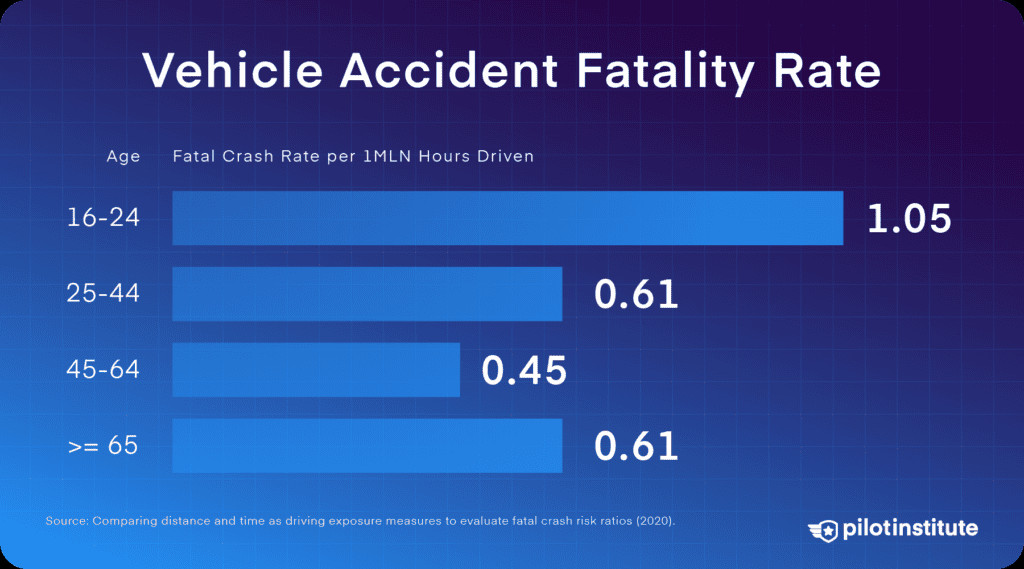 Vehicle accident fatality rate by age
Vehicle accident fatality rate by age
A 2020 study published by the National Center for Biotechnology Information (NCBI) offers a solution by converting driving fatalities to a per-hour basis. The research indicates 0.6 to 0.7 fatal car crashes per million hours driven, varying from 1.05 for young drivers to 0.45 for older drivers. Meanwhile, motorcycle accidents are about 27 times more frequent than car accidents per vehicle mile, equating to roughly 16 to 18 fatal motorcycle accidents per million hours ridden.
3. What Are the Accident Rates for Different Types of General Aviation Flights?
General Aviation includes a wide array of flight types, each with varying risk profiles. Here’s a breakdown:
- Overall GA: 9.5 fatal crashes per million flight hours (about 14 times the driving fatality rate).
- Personal Flights: 21.1 fatal accidents per million flight hours (over 27 times the driving fatality rate).
- Instructional Flights: 2.3 fatal accidents per million flight hours (about 3.4 times more dangerous than driving).
- Corporate Aviation: 0.48 fatal accidents per million flight hours (significantly safer than personal flights).
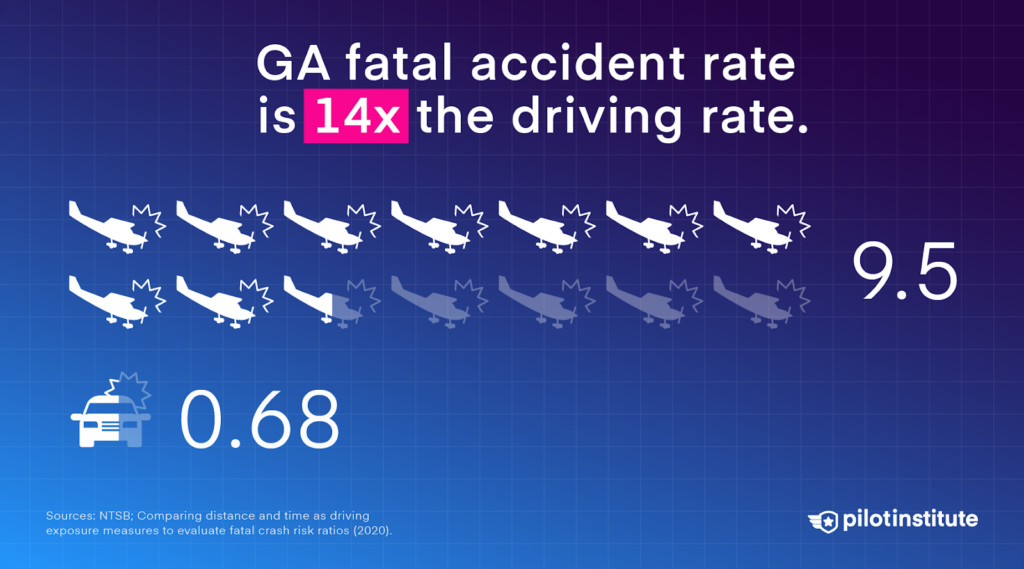 The GA fatal accident rate is roughly 14 times that of driving
The GA fatal accident rate is roughly 14 times that of driving
4. Why Are Personal GA Flights So Much More Dangerous Than Driving?
Personal flights, constituting 67% of GA accidents and 72% of GA fatalities, involve activities like short leisure trips. The high accident rate in this category can be attributed to several factors:
- Pilot Proficiency: Personal flights may be flown by pilots with less frequent flying hours, leading to decreased proficiency.
- Maintenance: Personal aircraft might not always be maintained as rigorously as those used in corporate or instructional settings.
- Risk Assessment: Personal flights may involve pilots taking unnecessary risks, especially when trying to adhere to a schedule or destination.
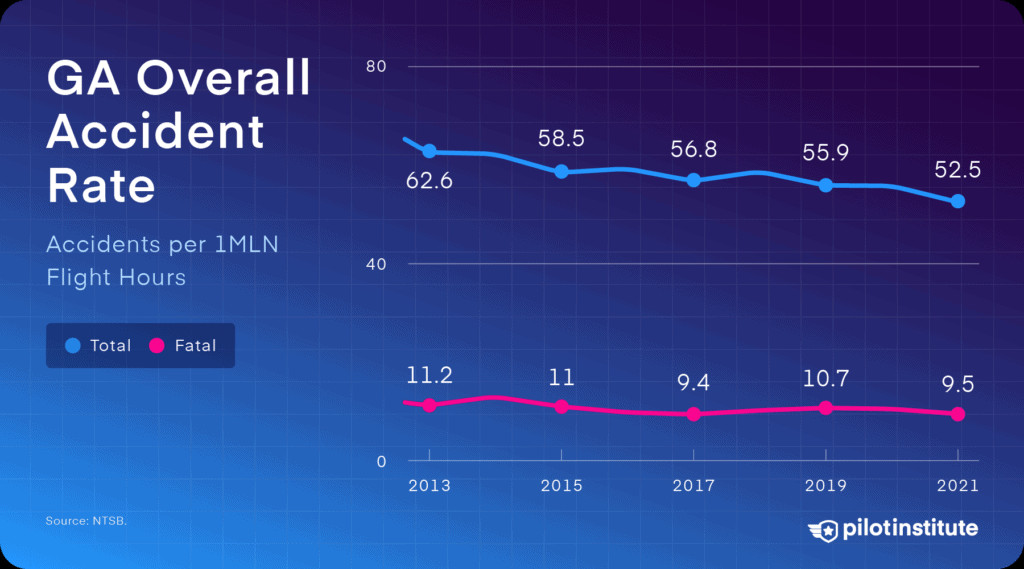 GA overall accident rate: 2012-2021
GA overall accident rate: 2012-2021
5. What Makes Instructional Flights Safer Compared to Other GA Flights?
Instructional flights benefit from a highly structured and supervised environment. Key safety factors include:
- Supervision: Flights are conducted with experienced instructors who can intervene in case of errors.
- Structured Operations: Flight schools adhere to strict operational procedures and safety protocols.
- Maintenance Standards: Instructional aircraft undergo frequent and thorough maintenance checks.
- Pilot Proficiency: Instructors are typically highly proficient and maintain their skills through regular flying.
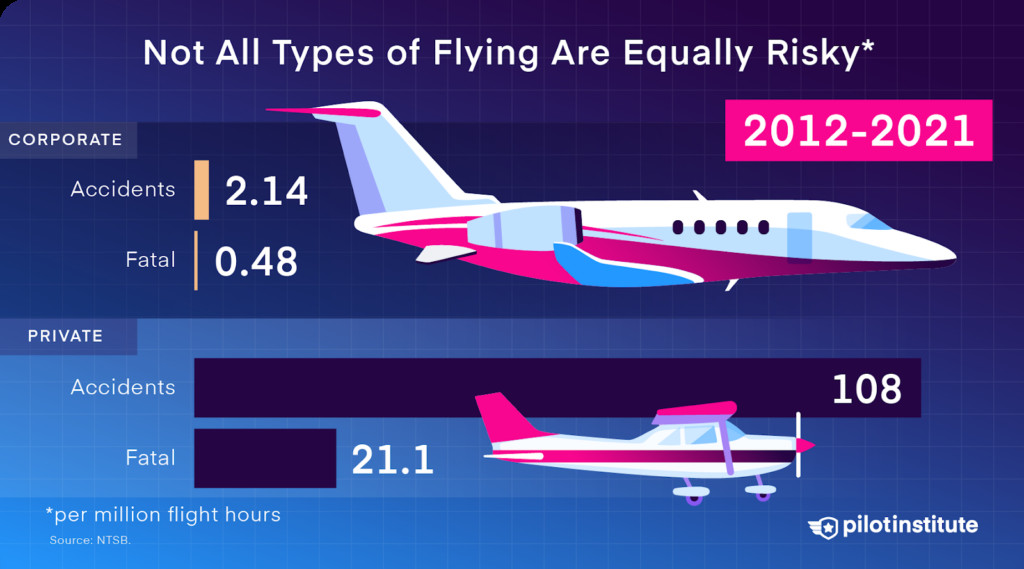 Corporate GA flying is quite safe compared to private flights
Corporate GA flying is quite safe compared to private flights
6. What Are the Primary Risk Factors Contributing to General Aviation Accidents?
According to the AOPA’s Richard G. McSpadden Report, accidents are divided into three categories: Pilot-related, Mechanical, and Other/Unknown causes.
- Pilot-Related: Pilot error accounts for the majority of GA accidents.
- Mechanical: Mechanical failures are the second most common cause but result in fewer fatalities.
- Other/Unknown: A significant percentage of accidents have undetermined causes, making prevention challenging.
 Personal flights account for the majority of total GA accidents and fatalities
Personal flights account for the majority of total GA accidents and fatalities
7. How Significant Is Pilot Error as a Cause of GA Accidents?
Pilot error is the leading cause of GA accidents, accounting for 69% of all incidents in 2021. The most common and fatal defining event is loss of control in-flight (LOC-I). Factors contributing to pilot error include:
- Loss of Control In-Flight (LOC-I): Often due to stalls, spins, or uncoordinated control inputs.
- Controlled Flight Into Terrain (CFIT): Occurs when a pilot inadvertently flies a functioning aircraft into terrain or obstacles.
- Unintended VFR Flight into IMC: Flying into instrument meteorological conditions without proper training or equipment.
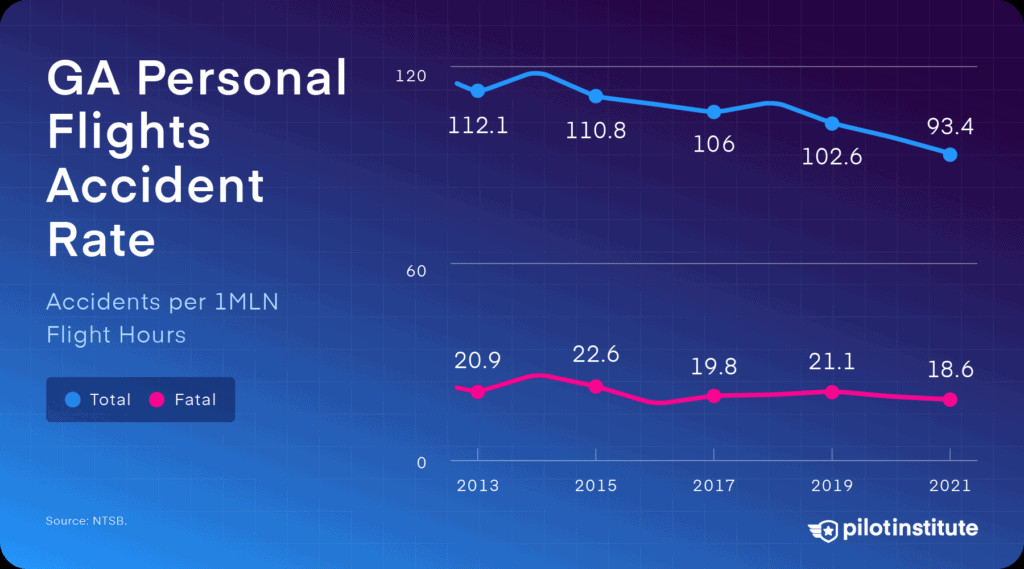 GA personal flights accident rate: 2012-2021
GA personal flights accident rate: 2012-2021
8. What Role Do Mechanical Failures Play in General Aviation Accidents?
Mechanical failures account for about 16% of all GA accidents but only 7% of fatal ones. While engine failures are the most significant mechanical issue, they are often manageable. Surprisingly, only a small fraction of engine failures result in fatalities. However, preventative maintenance and diligent pre-flight checks are essential to minimizing these risks.
Contributing factors include:
- Engine Failures: Can result from maintenance issues, structural failures, or preventable problems like carb ice.
- Fuel Issues: Include fuel contamination, fuel starvation, and fuel exhaustion, often due to pilot error or poor flight planning.
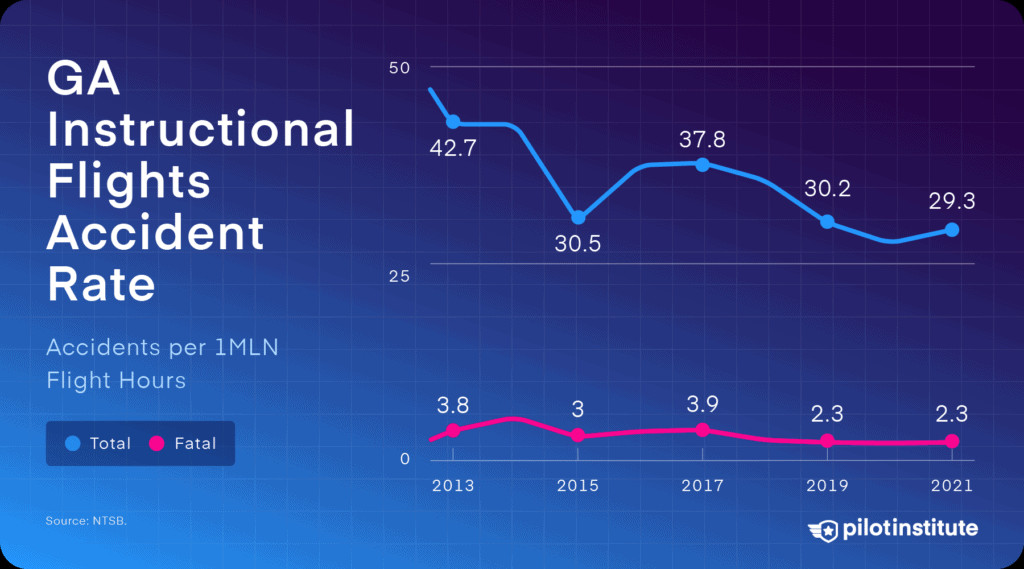 GA instructional flights accident rate: 2012-2021
GA instructional flights accident rate: 2012-2021
9. What Are Some Specific Examples of Pilot-Related Accident Causes?
Pilot-related accident causes can be further broken down into specific scenarios:
- Loss of Control In-Flight (LOC-I): This is the most common and fatal cause. It often results from flying too slow or making uncoordinated control inputs.
- Landing Accidents: These are frequent but typically less fatal. The most common cause is loss of control during landing.
- Takeoff and Climb Accidents: These accidents have a higher fatality rate due to the low-energy, low-altitude state of the aircraft.
- Controlled Flight Into Terrain (CFIT): This occurs when a pilot flies a functioning aircraft into the ground or an obstacle, often due to loss of situational awareness.
- Unintended VFR Flight into IMC: This is particularly deadly, with a high fatality rate due to the pilot’s inability to maintain control in instrument conditions.
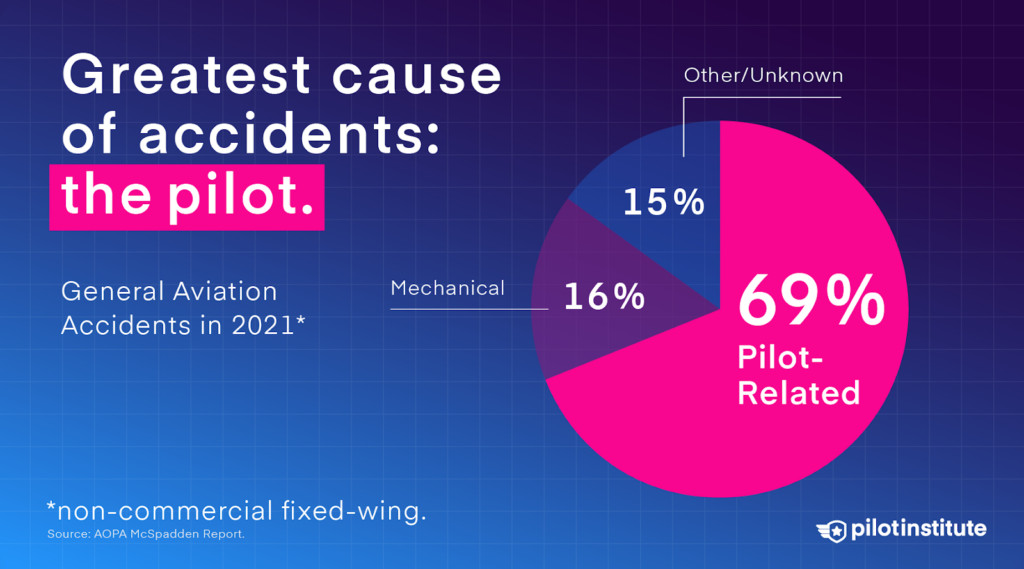 The greatest cause of GA accidents is the pilot
The greatest cause of GA accidents is the pilot
10. How Does Weather Contribute to GA Accidents, and What Can Pilots Do?
Weather plays a significant role in GA accidents, particularly when pilots fly into instrument meteorological conditions (IMC) without proper training or equipment. Unintended VFR flight into IMC had a 71% fatality rate in 2021. Other weather-related factors include:
- Icing: Can severely affect aircraft performance and control.
- Poor IFR Technique: Lack of proficiency in instrument flying can lead to disorientation and loss of control.
- Thunderstorms: Flying near or through thunderstorms can be catastrophic due to turbulence, hail, and other hazards.
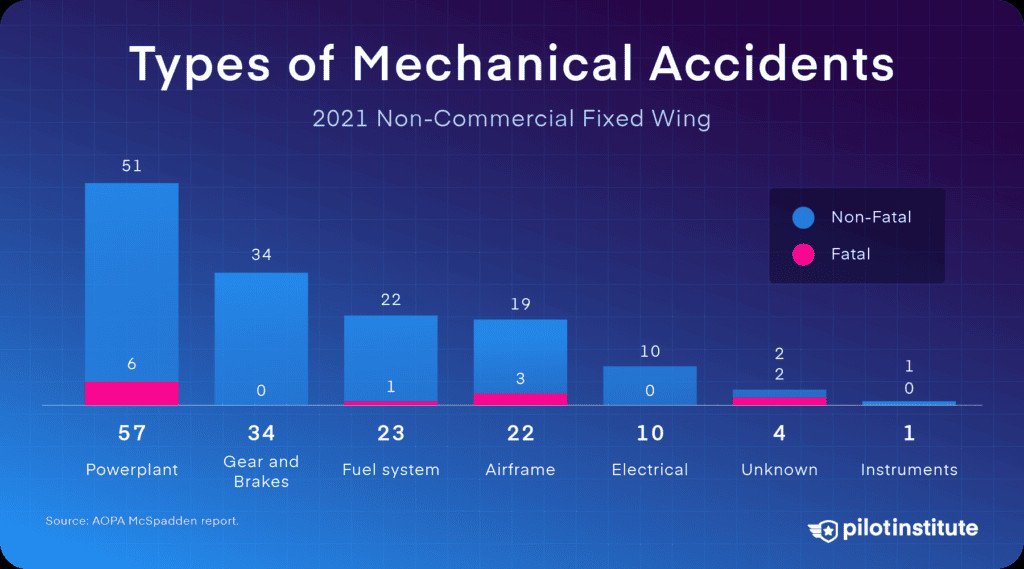 Types of GA mechanical accidents
Types of GA mechanical accidents
Pilots can mitigate these risks by:
- Thoroughly assessing weather conditions before flight.
- Avoiding flight in adverse weather.
- Maintaining proficiency in instrument flying.
- Ensuring the aircraft is properly equipped for the expected weather.
11. What Safety Measures and Best Practices Can Reduce Risks in General Aviation?
While GA flying may never be as safe as driving, pilots can take numerous steps to reduce risk:
- Proficiency Training: Go beyond legal minimums and engage in regular training to maintain and improve flying skills.
- Structured Operations: Model the safety mindset of flight schools and airlines by adhering to strict procedures and checklists.
- Risk Assessment: Conduct thorough risk assessments before each flight, considering factors like weather, pilot fatigue, and aircraft condition.
- Aircraft Maintenance: Ensure the aircraft is well-maintained and undergoes regular inspections.
- Continuous Learning: Stay informed about the latest safety recommendations and accident case studies to learn from others’ mistakes.
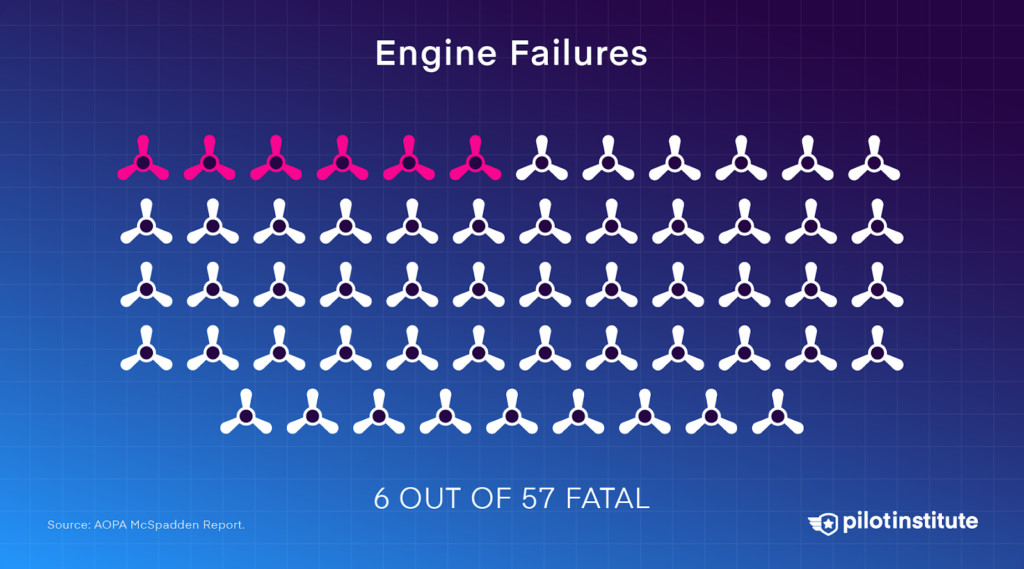 Six out of 57 engine failure accidents in 2021 were fatal
Six out of 57 engine failure accidents in 2021 were fatal
12. Why Is Understanding the “Impossible Turn” Important for Pilots?
The “impossible turn” is a risky maneuver attempted when an engine fails shortly after takeoff. Pilots try to turn back to the runway, but often lack the altitude and airspeed to complete the turn safely. Understanding the dangers of the impossible turn can help pilots make better decisions in emergency situations. It is generally safer to land straight ahead, even if it means landing off-airport.
13. What role does Currency vs Proficiency play in Aviation safety?
Currency refers to the legal minimums required to exercise the privileges of a pilot certificate. Proficiency goes beyond currency and involves maintaining a high level of skill and knowledge.
| Aspect | Currency | Proficiency |
|---|---|---|
| Definition | Meeting the legal requirements to act as pilot-in-command (PIC). | Maintaining a high level of skill, knowledge, and judgment through practice, experience, and continuous learning. |
| Requirements | – Flight review every 24 calendar months. – Three takeoffs and landings within the preceding 90 days to carry passengers. | – Regular practice flights and training. – Continuous self-assessment and improvement. – Staying updated with current regulations and best practices. |
| Focus | Compliance with FAA regulations. | Ensuring a high level of competence and readiness for any flight situation. |
| Safety Impact | Minimum standard for legal operation, but may not guarantee a high level of safety. | Enhances safety by ensuring the pilot is well-prepared to handle routine and emergency situations. |
14. How does the FAA Risk Assessment Matrix help mitigate risk?
The FAA Risk Assessment Matrix is a tool used to evaluate and manage risk by considering the likelihood and severity of potential hazards. It helps pilots and aviation professionals make informed decisions by identifying high-risk scenarios and implementing mitigation strategies.
| Likelihood | Severity | Risk Level | Mitigation Strategies |
|---|---|---|---|
| Frequent | Catastrophic | Unacceptable | Take immediate action to reduce or eliminate the risk. Ground the flight until the risk is mitigated. |
| Frequent | Hazardous | Unacceptable | Take immediate action to reduce or eliminate the risk. Delay the flight until the risk is mitigated. |
| Frequent | Major | High | Significant risk; require management’s attention. Implement mitigation strategies to reduce the risk to an acceptable level before proceeding. |
| Frequent | Minor | Medium | Acceptable with mitigation strategies. Monitor the risk and implement controls as necessary. |
| Probable | Catastrophic | Unacceptable | Take immediate action to reduce or eliminate the risk. Ground the flight until the risk is mitigated. |
| Probable | Hazardous | High | Significant risk; require management’s attention. Implement mitigation strategies to reduce the risk to an acceptable level before proceeding. |
| Probable | Major | Medium | Acceptable with mitigation strategies. Monitor the risk and implement controls as necessary. |
| Probable | Minor | Low | Acceptable; monitor the risk and implement controls as necessary. |
| Occasional | Catastrophic | High | Significant risk; require management’s attention. Implement mitigation strategies to reduce the risk to an acceptable level before proceeding. |
| Occasional | Hazardous | Medium | Acceptable with mitigation strategies. Monitor the risk and implement controls as necessary. |
| Occasional | Major | Low | Acceptable; monitor the risk and implement controls as necessary. |
| Occasional | Minor | Very Low | Acceptable; monitor the risk and implement controls as necessary. |
| Remote | Catastrophic | Medium | Acceptable with mitigation strategies. Monitor the risk and implement controls as necessary. |
| Remote | Hazardous | Low | Acceptable; monitor the risk and implement controls as necessary. |
| Remote | Major | Very Low | Acceptable; monitor the risk and implement controls as necessary. |
| Remote | Minor | Very Low | Acceptable; monitor the risk and implement controls as necessary. |
| Improbable | Catastrophic | Low | Acceptable; monitor the risk and implement controls as necessary. |
| Improbable | Hazardous | Very Low | Acceptable; monitor the risk and implement controls as necessary. |
| Improbable | Major | Very Low | Acceptable; monitor the risk and implement controls as necessary. |
| Improbable | Minor | Very Low | Acceptable; monitor the risk and implement controls as necessary. |
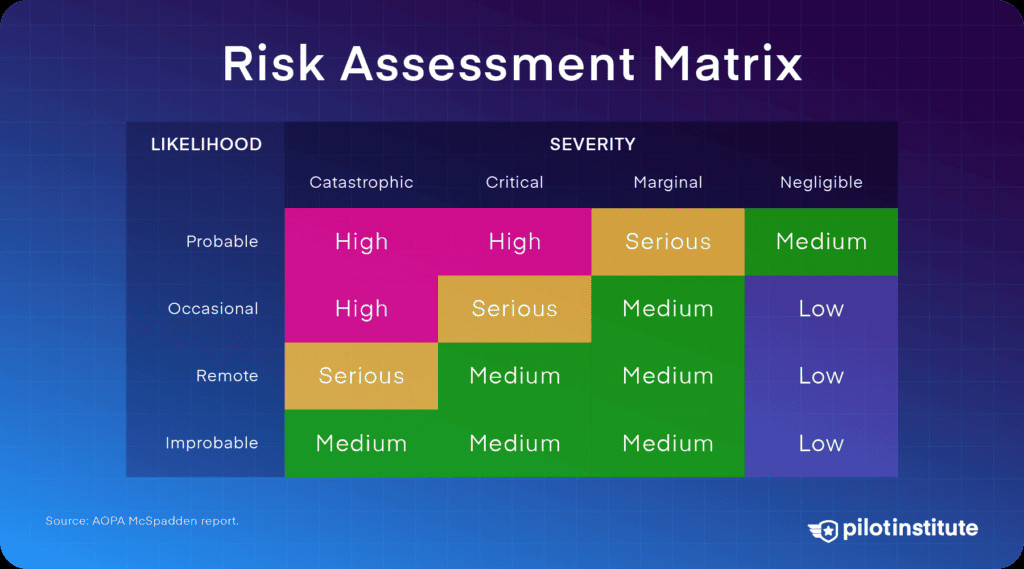 FAA Risk Assessment Matrix
FAA Risk Assessment Matrix
15. What Resources Does Flyermedia.net Offer to Enhance Aviation Safety?
At flyermedia.net, we are dedicated to providing a comprehensive resource for aviation enthusiasts and professionals alike. We offer:
- Up-to-date News and Articles: Stay informed about the latest aviation news, safety recommendations, and technological advancements.
- Training Information: Explore detailed information about flight schools, pilot certifications, and advanced training programs.
- Career Opportunities: Discover job opportunities in the aviation industry and the requirements for various roles.
- Expert Insights: Access articles and analysis from experienced pilots, engineers, and aviation professionals.
- Safety Tips and Best Practices: Learn about the best practices for safe flying and how to mitigate risks.
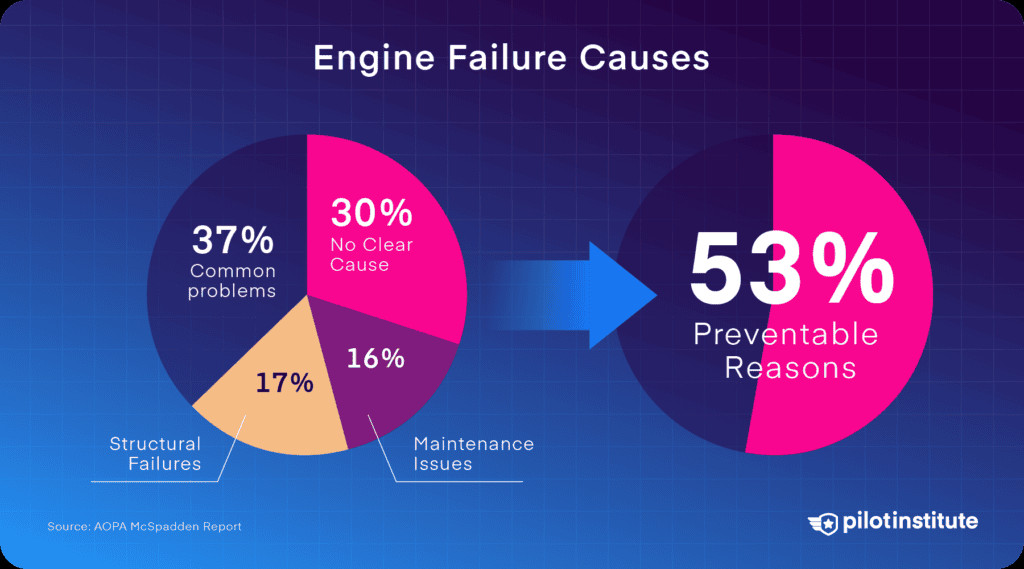 A diagram depicting the reasons for engine failures
A diagram depicting the reasons for engine failures
By visiting flyermedia.net, you can enhance your knowledge, stay current with industry trends, and take proactive steps to ensure safer flying. Whether you’re a student pilot or a seasoned aviator, we have something for everyone.
16. How Can Pilots Develop a Safety-First Mindset?
Developing a safety-first mindset involves making disciplined and wise decisions, even when no one is watching. This includes:
- Adhering to Checklists: Always use checklists to ensure all pre-flight and in-flight procedures are followed.
- Continuous Learning: Stay updated on safety recommendations and accident case studies.
- Self-Assessment: Regularly evaluate your skills and knowledge to identify areas for improvement.
- Risk Management: Conduct thorough risk assessments before each flight and be willing to cancel or delay flights when necessary.
- Humility: Recognize your limitations and avoid taking unnecessary risks.
17. What is Controlled Flight Into Terrain (CFIT) and how can it be avoided?
Controlled Flight Into Terrain (CFIT) is an accident in which an airworthy aircraft, under the control of the pilot, is unintentionally flown into terrain (ground, mountains, or obstacles). The aircraft is fully functional, but the pilot is unaware of the impending collision.
| Factor | Description | Mitigation Strategies |
|---|---|---|
| Loss of Situational Awareness | Pilots lose track of their position, altitude, and surrounding terrain. | – Use advanced navigation systems (GPS, moving map displays). – Regularly cross-check position with multiple sources. – Practice and maintain proficiency in instrument flying. |
| Failure to Adhere to Minimum Altitudes | Pilots descend below safe altitudes due to pressure to maintain schedule or poor planning. | – Strictly adhere to minimum safe altitudes. – Plan routes carefully to ensure adequate clearance. – Use altitude alerts and warnings. |
| Distraction or Complacency | Pilots become distracted or complacent, leading to errors in judgment. | – Maintain focus during critical phases of flight. – Use sterile cockpit procedures during takeoff, landing, and approaches. – Avoid distractions and unnecessary tasks in high-workload situations. |
| Inadequate Flight Planning | Poor planning leads to insufficient fuel, unfamiliarity with terrain, and unexpected weather conditions. | – Conduct thorough pre-flight planning, including weather briefings, route analysis, and alternate airport selection. – Ensure sufficient fuel reserves. – Be prepared to divert or delay the flight if conditions change. |
| Adverse Weather Conditions | Reduced visibility and challenging weather make it difficult for pilots to see and avoid terrain. | – Avoid flying in adverse weather conditions. – Use weather radar and other tools to monitor conditions. – Be prepared to divert or delay the flight if weather deteriorates. – Maintain proficiency in instrument flying. |
| Night Flying | Reduced visibility at night increases the risk of CFIT. | – Ensure adequate lighting on the aircraft and at the airport. – Use night vision goggles (NVGs) if available and proficient. – Maintain proficiency in night flying techniques. – Plan routes carefully and be aware of terrain. |
| Complex Instrument Approaches | Pilots become disoriented during complex instrument approaches, especially in mountainous terrain. | – Practice instrument approaches in a simulator. – Use flight management systems (FMS) and autopilot. – Brief the approach thoroughly before starting. – Use proper crew resource management (CRM) techniques if flying with a crew. – Maintain a high level of situational awareness. |
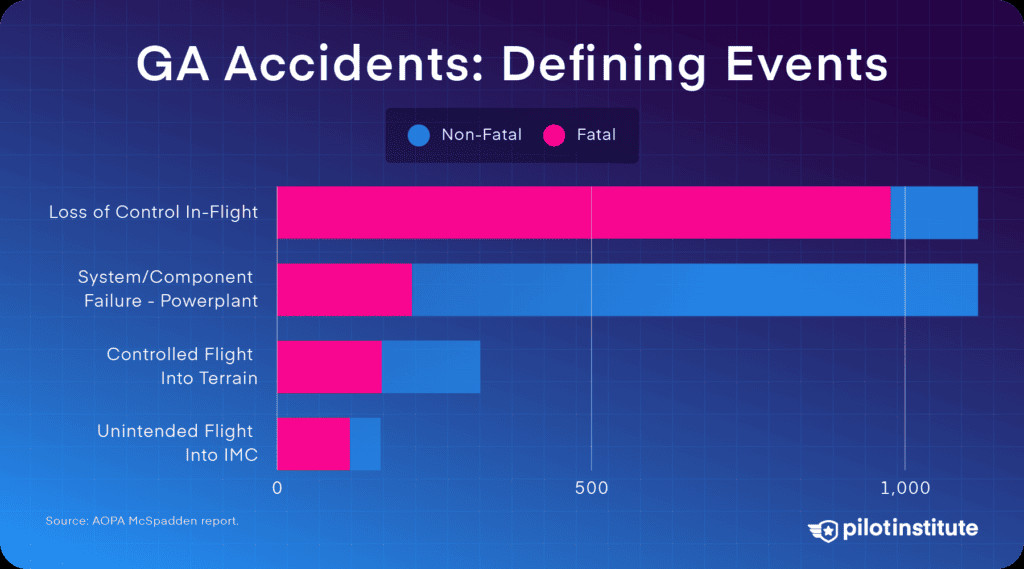 A selection of GA accident defining events
A selection of GA accident defining events
18. Why is unintended VFR flight into IMC so dangerous?
Unintended VFR (Visual Flight Rules) flight into IMC (Instrument Meteorological Conditions) is a highly hazardous situation because it places pilots who are trained and equipped for visual flight into conditions requiring instrument flight skills and equipment. This often leads to spatial disorientation, loss of control, and fatal accidents.
| Factor | Description | Mitigation Strategies |
|---|---|---|
| Loss of Visual References | In IMC, pilots lose external visual references, such as the horizon and ground features, making it difficult to maintain orientation and control. | – Maintain proficiency in instrument flying (IFR). – Obtain an instrument rating. – Use flight instruments to maintain orientation and control. |
| Spatial Disorientation | The lack of visual references can lead to spatial disorientation, where pilots experience false sensations about the aircraft’s attitude, motion, and position. | – Trust flight instruments over personal sensations. – Practice spatial disorientation recovery techniques in a simulator. – Avoid sudden head movements. |
| Lack of Instrument Training and Equipment | VFR pilots often lack the training and equipment necessary to safely fly in IMC, including instrument rating, instrument-rated aircraft, and knowledge of instrument procedures. | – Obtain an instrument rating. – Fly aircraft equipped for instrument flight. – Maintain proficiency in instrument procedures. |
| Deteriorating Weather Conditions | Rapidly changing weather can quickly reduce visibility and create IMC conditions, catching VFR pilots unprepared. | – Obtain thorough pre-flight weather briefings. – Monitor weather conditions continuously during the flight. – Be prepared to divert or turn back if weather deteriorates. |
| Pressure to Continue the Flight | Pilots may feel pressured to continue the flight due to schedule, destination, or other factors, leading them to make poor decisions. | – Make conservative go/no-go decisions. – Be prepared to divert or delay the flight if conditions are not safe. – Prioritize safety over schedule. |
| Inadequate Pre-Flight Planning | Poor planning can result in insufficient fuel, unfamiliarity with the route, and a lack of alternate airports. | – Conduct thorough pre-flight planning, including weather briefings, route analysis, and alternate airport selection. – Ensure sufficient fuel reserves. – Familiarize yourself with the route and terrain. |
| Failure to Recognize and Respond to IMC | Pilots may fail to recognize the onset of IMC or may delay taking appropriate action, such as turning back or diverting to an alternate airport. | – Recognize the signs of deteriorating weather. – Respond promptly and decisively to IMC conditions. – Turn back or divert to an alternate airport if necessary. |
| Ice | Can severely affect aircraft performance and control | – Avoid flying in icing conditions. – Use de-icing equipment and procedures. |
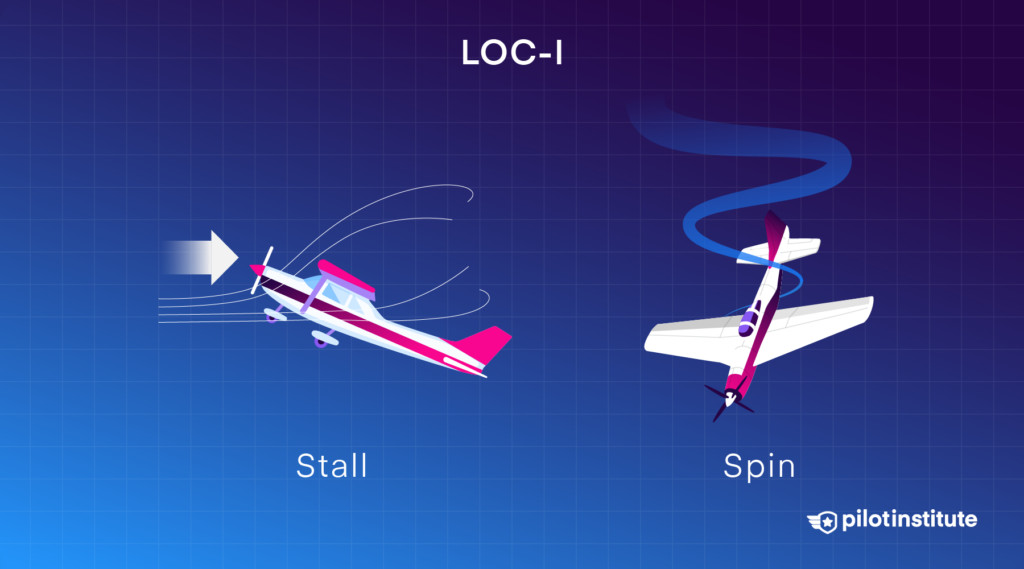 Loss of Control In-Flight: the leading cause of fatal accidents
Loss of Control In-Flight: the leading cause of fatal accidents
19. How can pilots manage the risks associated with takeoff and climb?
Managing the risks associated with takeoff and climb involves careful planning, adherence to procedures, and a thorough understanding of aircraft performance.
| Factor | Description | Mitigation Strategies |
|---|---|---|
| Pre-Flight Planning | Proper planning is crucial to identify potential hazards and ensure a safe takeoff and climb. | – Calculate takeoff and climb performance based on weight, altitude, temperature, and wind. – Review airport diagrams and identify potential obstacles. – Plan for emergency procedures in case of engine failure or other malfunctions. – Ensure proper aircraft configuration and checklists are completed. |
| Aircraft Performance | Understanding the aircraft’s capabilities is essential for a safe takeoff and climb. | – Operate within the aircraft’s weight and balance limits. – Use proper takeoff and climb speeds. – Monitor engine performance and respond to any abnormalities. – Be aware of the aircraft’s stall speed and angle of attack. |
| Wind Conditions | Wind can significantly affect takeoff and climb performance. | – Determine wind direction and speed before takeoff. – Use proper wind correction techniques. – Be aware of wind shear and turbulence. |
| Obstacles | Obstacles near the runway can pose a significant hazard during takeoff and climb. | – Review airport diagrams and identify potential obstacles. – Calculate climb gradients to ensure adequate obstacle clearance. – Use visual aids, such as VASI or PAPI, to maintain proper glide path. |
| Engine Failure | Engine failure during takeoff or climb is a critical emergency. | – Train for engine failure procedures in a simulator. – Maintain situational awareness and identify potential landing sites. – Use proper emergency procedures to maintain control of the aircraft. – Consider the “impossible turn” only if there is sufficient altitude and airspeed to safely return to the runway. |
| Stall Awareness and Prevention | Stalls during takeoff and climb can be deadly. | – Use proper takeoff and climb speeds. – Monitor angle of attack and airspeed. – Avoid abrupt control inputs. – Recognize and recover from stalls. |
| Situational Awareness | Maintaining situational awareness is crucial for a safe takeoff and climb. | – Monitor airspeed, altitude, and heading. – Use checklists to ensure proper aircraft configuration. – Communicate with ATC and other crew members. – Be aware of potential hazards and respond to any abnormalities. |
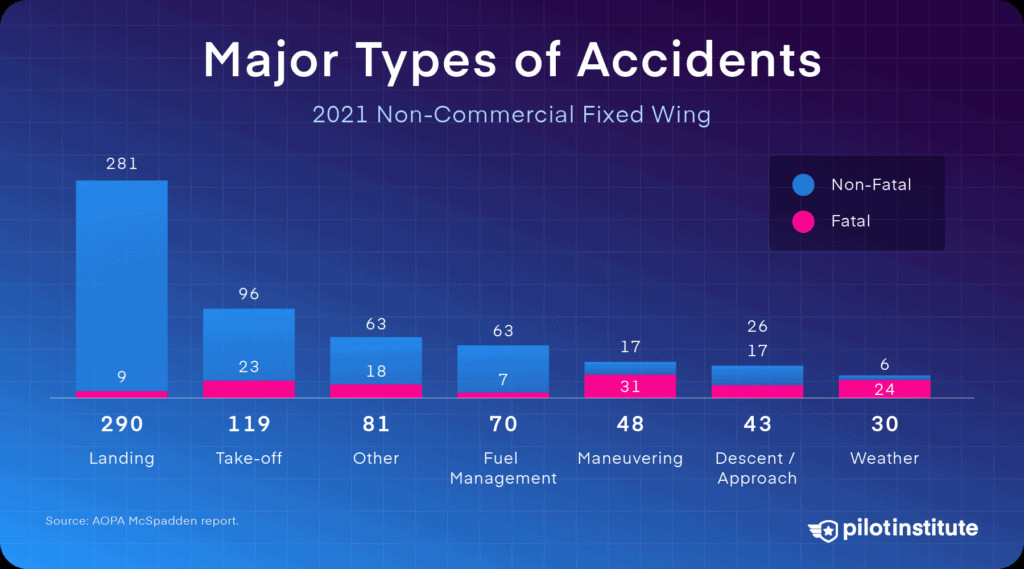 Major types of GA accidents
Major types of GA accidents
20. Is it safer to drive or fly? What are some key safety differences between driving and flying?
While flying can be more dangerous than driving, especially in general aviation, it’s essential to recognize key safety differences:
| Safety Aspect | Driving | Flying (General Aviation) |
|---|---|---|
| Accident Rates | Lower accident rates per hour compared to personal GA flights. | Higher accident rates per hour, particularly for personal GA flights. |
| Pilot Qualifications | Anyone with a valid driver’s license can operate a vehicle. | Requires extensive training, certification, and ongoing proficiency. |
| Regulations | Subject to traffic laws and vehicle safety standards. | Heavily regulated by aviation authorities (FAA in the USA) with strict rules for aircraft maintenance, pilot certification, and flight operations. |
| Risk Factors | Driver error, road conditions, vehicle maintenance, weather. | Pilot error, mechanical failures, weather conditions, air traffic control. |
| Emergency Response | Emergency services are readily available on roads. | Emergency landing options may be limited, especially in remote areas. |
| Human Factors | Fatigue, distraction, impaired driving, speeding. | Fatigue, decision-making, situational awareness, stress. |
| Aircraft Maintenance | Vehicle maintenance is often less rigorous than aircraft maintenance. | Aircraft must undergo regular inspections and maintenance to comply with aviation regulations. |
| Weather Impact | Weather can affect driving conditions, but generally less critical than in aviation. | Weather has a significant impact on flight safety, requiring pilots to make informed decisions based on weather conditions. |
| Training | Driver training varies widely but generally less extensive than pilot training. | Pilot training is standardized and requires extensive hours of instruction, flight time, and testing. |
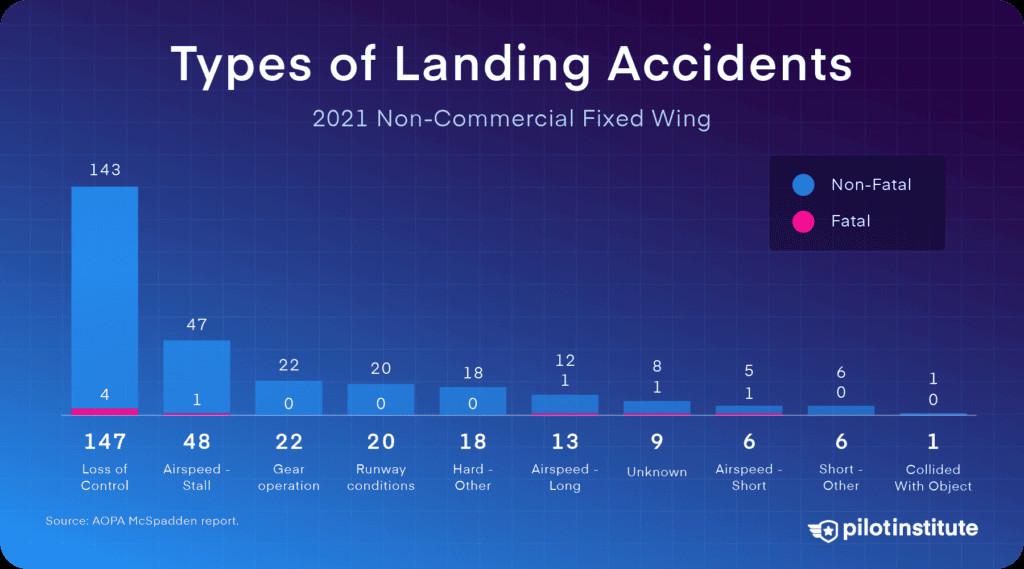 Types of GA landing accidents
Types of GA landing accidents
Whether you choose to drive or fly, safety should always be the top priority. Visit flyermedia.net for more information on aviation safety, training, and career opportunities.
FAQ: Is It Safer to Drive or Fly?
- Is it statistically safer to fly on a commercial airline or drive a car?
- Flying on a commercial airline is statistically safer than driving a car.
- What makes general aviation (GA) flights riskier than commercial flights?
- GA flights often involve less experienced pilots, smaller aircraft, and less stringent safety regulations.
- What is the most common cause of accidents in general aviation?
- Pilot error is the most common cause of accidents in general aviation.
- How does weather impact the safety of GA flights?
- Adverse weather conditions can significantly increase the risk of accidents in GA flights.
- What are some ways pilots can mitigate risks in GA flying?
- Pilots can mitigate risks through proficiency training, thorough pre-flight planning, and adherence to safety checklists.
- Are mechanical failures a significant cause of GA accidents?
- Mechanical failures contribute to a significant number of GA accidents, though they are typically less fatal than pilot-related accidents.
- What is “loss of control in-flight” (LOC-I), and why is it dangerous?
- LOC-I is when a pilot loses control of the aircraft, often leading to stalls, spins, and fatal accidents.
- How do instructional flights compare to personal flights in terms of safety?
- Instructional flights are generally safer due to the presence of experienced instructors and structured training environments.
- What role does the FAA play in ensuring aviation safety?
- The FAA sets and enforces regulations for pilot certification, aircraft maintenance, and flight operations.
- Where can I find more information and resources on aviation safety?
- Visit flyermedia.net for up-to-date news, training information, and expert insights on aviation safety.
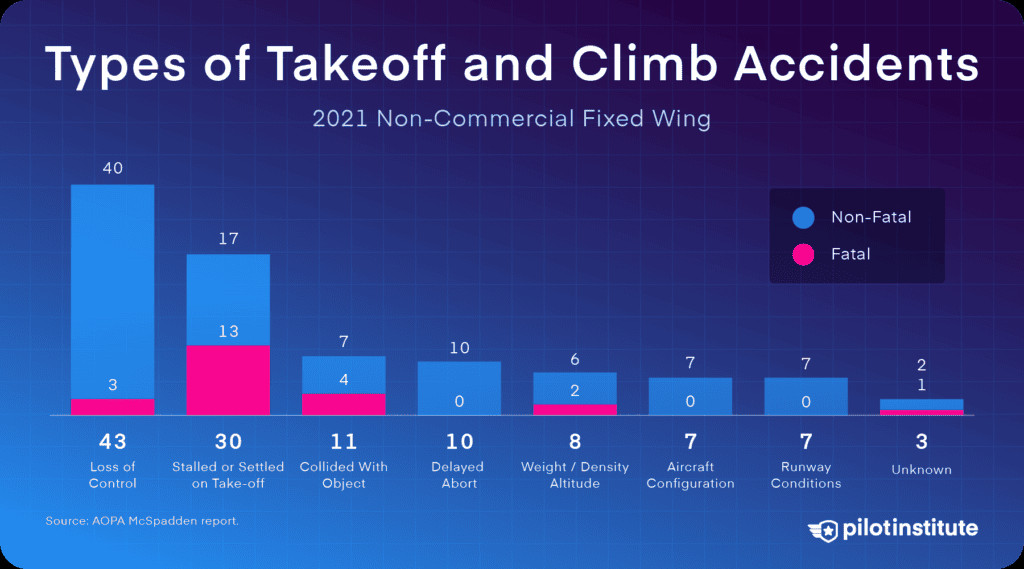 Types of GA takeoff and climb accidents
Types of GA takeoff and climb accidents
At flyermedia.net, we’re committed to providing the resources and information you need to make informed decisions about aviation and your career. Whether you’re looking for the latest news, expert advice, or training opportunities, we’re here to help you achieve your goals in the exciting world of aviation. Explore flyermedia.net today and take the next step toward your aviation dreams!
Address: 600 S Clyde Morris Blvd, Daytona Beach, FL 32114, United States
Phone: +1 (386) 226-6000
Website: flyermedia.net
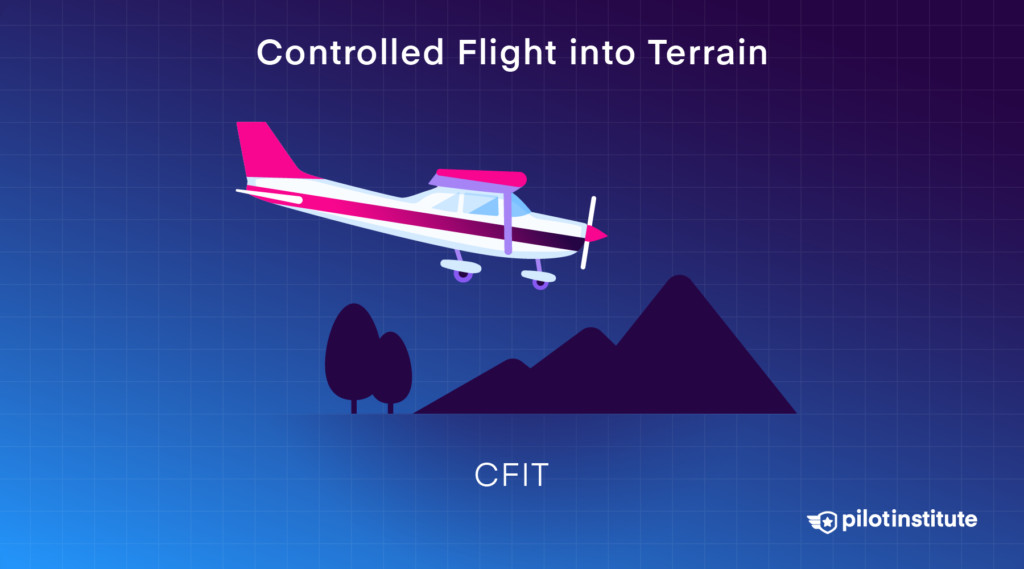 Controlled Flight into Terrain: a top cause of fatal accidents
Controlled Flight into Terrain: a top cause of fatal accidents
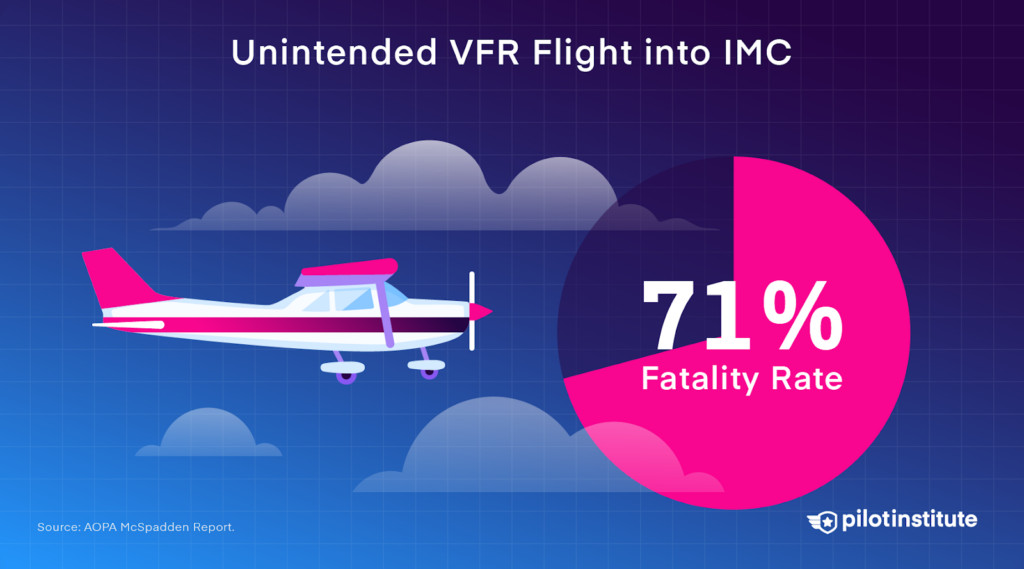 Unintended VFR flight into IMC has a 71% fatality rate
Unintended VFR flight into IMC has a 71% fatality rate